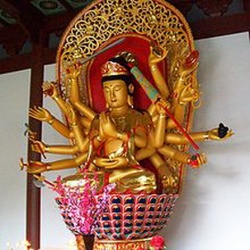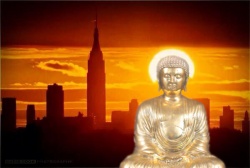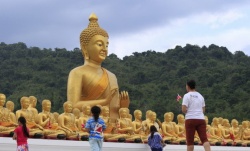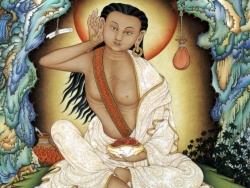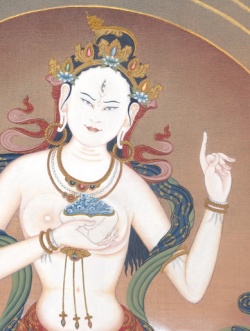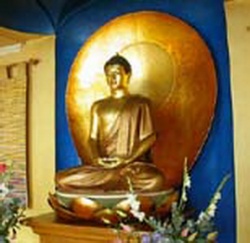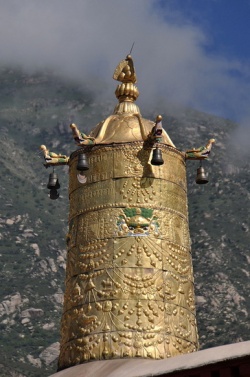After-death experience
Tibetan Buddhism has concentrated more attention on helping the dying person cross the borders of death than any other living religious tradition. The Tibetan Book of the Dead and other sources give detailed descriptions of the stages of death and afterlife, as well as instructions about how the dying individual should confront and react to these mysterious places and events. Dealing with a tradition that contains so many lineages, deities, and philosophical subsystems in a short article will necessarily involve generalizing about the tradition. Though the material is complex and sometimes difficult to interpret for a Westerner who must rely on English sources, the author will describe the stages of death, and attempt to show how they are relevant to our discussion of spiritual travel.
The Bardos or Stages of Death and the Afterlife
The realm of the afterlife is called the world of the bardo. The term bardo is a general term which literally means "in-between" and in this context denotes a transitional state, or what Victor Turner calls a liminal situation. The bardo concept is an umbrella term which includes the transitional states of birth, death, dream, transmigration or afterlife, meditation, and spiritual luminosity. We focus, in this essay, on the bardos of death and transmigration. For the dying individual, the bardo is the period of the afterlife that lies in between two different incarnations.
In Tantric Buddhist cosmology, existence has a foreground which consists of the many worlds of incarnation, and also a background which is the space between these worlds which is called the bardo world. The stars are the many worlds, and bardo of the afterlife is like the night sky which is the backdrop or the space where the stars are hung.
The bardo of death follows the initial experience of the dissolution of the four elements of the physical body at the time of death. These consist of something similar to the concepts of earth, fire, water, and air in the West, and are related to the progressive dissociation of the soul from the physical body. This dissolution follows a prescribed progression: the senses fail and the muscles lose their strength as the body becomes inert and still resembling physical matter (earth), there is loss of control over bodily fluids (water), the body loses its warmth (fire), and the breath fails (air). All this is experienced in sequence by the dying person when the person is able to remain conscious during the bardo of death.
Note here that the "soul" in Tibetan Buddhism is only a collection (or bundle) of karma (credits and debits based on previous actions which mold both the habit patterns of the individual and the kinds of conditions encountered in life). In Buddhism, the soul has no substantial nature but otherwise the soul and this "collection" seem very similar and are functionally equivalent for our purposes. We therefore use the term soul above even though it is not a Buddhist term.
The Bardo of Death
Following the process leading up to death, the person's experience of the bardo of death commences. However, for most individuals, it passes by in a split second and goes unnoticed. Only those who have undergone training in and practiced meditation, contemplative prayer, and similar spiritual disciplines will likely even be aware of the first bardo state.
One description of the kind of meditation done by advanced practitioners consists of a conscious effort to "dissolve space into light", which if successful will propel the dying soul into an a state of light and bliss beyond the continual cycles of birth and death to which most souls are subject. For those less familiar with such formal meditation practices, the act of remembering very bright light (such as, for example, remembering an experience of staring into the sun) and seeing that light as a source of pure awareness or divine love could produce a similar effect. A series of meditations and understandings that can be helpful as one enters or prepares to enter the bardo can be found on our Death Meditations page.
The spiritual aperture that opens briefly at the time of death presents a wonderful opportunity to those who can remain conscious and control their thoughts as they enter the bardo of death. This is probably why there is a common folk belief in the Hindu tradition which puts much emphasis on controlling and directing the last thought of the dying person. If this thought is strong, clear, and of a spiritual nature, it may permit the person to enter through this doorway into a spiritual world immediately at the time of death, and thus avoid the confusion of the bardo of the afterlife (or transmigration)
The First Bardo of the Afterlife
Following the bardo of death, the first bardo of the afterlife begins. For many souls including especially those fortunate souls who were spiritual seekers and have sought spiritual experience during life through religious practice, there will be several opportunities to meet with spiritual beings and enter the realms of enlightened beings. As such beings appear, they are sometimes frightening to the individual because of their spiritual power. Their appearance is accompanied by powerful lights and sounds that frighten and bewilder those who have not encountered intense spiritual states in the past. The spiritual light is described as having a terrifying brilliance and as luminous, clear, bright, and sharp.
The individual is also presented with a means of ending these encounters by paying attention to images and lights that feel comforting and familiar, and sometimes represent one of the passions that appeal to the person. This is where people's unconsciousness tendencies take control as they are variously attracted to jealously which can bring future lives of fighting and quarreling, pride which leads to another human rebirth, or aggression and violence which can lead to a rebirth in a hell world. Being attracted to these lights and images will cause the spiritual being to disappear and the opportunity to gain insight and enter their spiritual world will be lost. This is one of the important reasons for learning spiritual travel so that encounters with powerful spiritual states of consciousness become familiar and desirable instead objects of fear to be avoided.
For those experienced in spiritual travel who were able to enter spiritual states of light, sound, and emptiness during life, the first bardo may offer an opportunity to enter into these areas shortly after the time of death. Also, those with a devotional disposition who were able to develop a strong bond with a deity during life may have similar opportunities to enter into one of the heavens of that deity during the first bardo. The devotion must usually be intense and concentrated to draw the deity's attention in this circumstance. Also, those who were devoted to a guru or spiritual guide during life can call upon that being and ask for guidance. Although the Tibetan Buddhist tradition is not primarily devotional, it like most of the world's great religious traditions contains devotional aspects where practicianers are encouraged to focus on powerful teachers or saints of the past or present as well as dakinis, bhairavas, Bodhisattvas, Buddhas, and other helpful beings.
The Second Bardo of the Afterlife
If the first bardo passes and attempts to access spiritual states were unsuccessful, the next bardo begins. The second bardo or the "bardo of becoming" is a stage in which the desires of the individual are said to carry the largely helpless soul through a great variety of intense emotional states. Good thoughts bring great bliss and pleasure, and hateful or negative thoughts bring great pain and desolation. The soul bounces from thought to thought as a torrent of thoughts and feelings come like a waterfall. Existing thought habits and desires are said to define the experience of the soul during the afterlife in this way.
Spiritual Travel and the Second Bardo
It is here where some experience and training in spiritual travel and out-of-body experience may be of greatest help. It may first help the individual maintain a state of detachment. The spiritual traveler who has experienced the inner world during life can take the whirlwind nature of inner world following death with more calm and detachment. Those who have read examples of the kinds of states encountered in spiritual travel located on other pages of this site will understand that some experimentation and discovery in the inner worlds may prepare the soul for many of the dynamics of the states it may encounter after death. The similarity of certain aspects of the near-death experience (a temporary bardo state) and elements of spiritual travel experience (the "tunnel" experience for example) show some common qualities between certain spiritual travel states and these bardo states.
The soul experienced in spiritual travel is less likely to be disoriented by this inner torrent of psychic experience. To put it another way, while the spiritual traveler or yogi swims through the ocean of consciousness, the inexperienced soul may feel more like it is drowning in that ocean. But as with a drowning person, the most important thing is to have a direction in which to swim to safety. The point of orientation or goal for the person in the second bardo may be a deity, a mantra, a prayer, a heaven, a guide, or some similar spiritual goal but the spiritual traveler must be able to focus and move towards that goal using meditative techniques learned and practiced during their former life in the physical world. This is the active approach of the spiritual traveler.
The second advantage is that the spiritual traveler has entered the waters of consciousness consciously on many occasions and is practiced at directing his or her experience in the inner worlds.
The greatest problems of the soul in the second bardo are negative emotions like guilt and fear (which results from a lack of familiarity with the inner worlds), and lack of conscious control over its own experience. Fear is particularly harmful because it fragments the self making concentration on one thing difficult or impossible, and this can lead to confusion and loss of conscious control.
The soul in the second bardo is many times caught in a dream state sometimes unaware that it has died, and incapable of taking action to raise its state of consciousness to a threshold level of awareness where it can direct its attention towards spiritual states.
This is one of the reasons it is important to do a regular spiritual practice during life. Doing meditation or prayer every day establishes a pattern of spiritual activity. It then becomes automatic and the habit of seeking after the divine reality continues during the after-death state where it can have powerful results. A daily spiritual practice differs from other more common spiritual practices such as going to church or temple because it is done more often than once or twice a week. Meditation therefore establishes a stronger habit pattern in the individual and is a valuable addition to group oriented spiritual activities such as attending church.
Regular meditation can also be more powerful because it is usually a less passive activity than church since it fully involves the individual in the meditative process rather than making a spectator out of him or her.
What the soul in the second bardo needs to do is "wake up", as in a lucid dream, and begin a meditation or mental exercise that draws it towards a desired stable and more conscious state of awareness where it can have some control and continue to evolve spiritually. The opposite of conscious control is a dream-like state where the individual experiences only the results of his or her previous actions, and mechanically moves from thought to thought based on thinking patterns developed during life.
Waking up within a dream is one of the activities the spiritual traveler practices when he or she leaves the body to travel the inner planes. Beyond this, the traveler is also always practicing and perfecting the art of directing his or her attention towards some desired state. It is the contention of the author that experience with meditation and actual spiritual travel experience during life can both be of great help in rising above the semi-conscious state characteristic of the second bardo, and moving into a more conscious and desirable state following physical death.
For those who practiced a devotional tradition in life, some will semi-consciously repeat a religious or a meditative ritual asking gods or intercessors to draw them out of the second bardo world. We see an example of an attempt to create such a ritual in the Catholic rosary, where Mary as intercessor is requested to
Pray for us sinners, now and at the hour of our death ...
This phrase is from the Hail Mary Prayer. One effect of the repetition of this prayer fifty times in the rosary is that such a prayer for help and intercession may become an automatic process, which will repeat itself in the bardo.
For those fortunate enough to be more conscious in these bardo states, a petition to a god, guru, guide, saint, or intercessor can be made in hopes that the individual will be lifted or guided out of the bardo worlds by one of those entities. But here again, the call must be concentrated and the ability to ignore the surrounding chaos somewhat developed. When such grace is given, it is a form of salvation where the individual is saved from the discomfort and confusion of the "outer darkness" of the bardo by a powerful entity - usually one that individuals formed a bond with in their former life. To use the swimming analogy, here the individual calls out to a lifeguard in hopes of being rescued from the turbulent waters of the bardo state. This is the more passive approach of the devotee.
We should also note that souls in this bardo are thought to be very sensitive to the thoughts and attitudes of those they knew during life. The Tibetans therefore put great effort into doing chanting, reading of sacred texts, and other religious rituals to help the dying soul on its journey in the afterlife. Praying for the peace and happiness of the dying person therefore has great value and provides a benefit to both the living and the dead. This process of sending good wishes to those who have recently died can create a positive spiritual atmosphere which can orient and bring peace to the person in the bardo realm, and can also counter some of the sorrow and upset that accompanies the loss of a loved one.
The Third Bardo
The third and last stage of the bardo of the afterlife is the stage of reincarnation where the soul is pulled into another body to start a new life, often but not always in the physical world. Tibetan Buddhists believe that the most desirable world to be born in is the physical world, since it affords the most opportunity for spiritual growth and realization. The third bardo consists of a series of images determined by the soul's karma that lead to psychic vortices that draw the soul into a womb. The soul's reaction to the images (attraction or repulsion) determines which vortex the soul enters and in which womb the soul ends up. The Tibetan tradition gives detailed advice on which representations to choose and which to avoid in order to gain a desirable rebirth. Once reborn, the karma of impulse manifests to influence the person's actions and reactions in their new life.
This ability to choose a good incarnation requires discrimination, and a certain degree of conscious awareness. The new age approach to reincarnation which claims we choose our new incarnation is idealistic and not always true from this vantage point. Many souls desperate to escape the confusion of the second bardo will grab on to the first opportunity that presents itself like a swimmer who grasps a log in dangerous rapids in hopes of making it to calmer waters. Choosing the first object (or incarnation) that comes along may not be the wisest choice.
The average person is said to spend a period of about forty-five days in the second bardo. However, passionate souls with strong desires or those responsible for evil acts in their most recent life are said to reincarnate almost immediately. In exceptional cases, the individual can stay in the bardo state for longer periods, and be drawn into its currents awaiting rebirth.
If the individual does not reincarnate in the physical world, he or she will go to one of the other five worlds of rebirth. These are the heaven worlds, the hell worlds, the world of hungry ghosts, the asura (demigod) worlds, and the animal worlds. Each of these is believed to be limited and inferior to obtaining another body in the material world. This is because they exist mostly to receive good or bad karma (the results of previous actions), and are not considered places to create new karma.
The least familiar of the above worlds is the asura world which is a place of conflict and struggle where kings, knights, and warlords battle each other for dominance. Persons who were fascinated with gaining and exercising power over others during life are said to be likely to incarnate in the asura realm.
The asura realm also offers the potential for rapid learning where the individual's actions produce clear and dramatic effects without generating the powerful karmic ripples that would normally occur in the physical world. It can thus be a kind of remedial world for those who are caught in negative repeating patterns which incline them to make bad decisions in the physical world incarnation after incarnation.
The hungry ghost realm is a place of need and desire where souls are denied fulfillment or given only small rewards. Here souls experience states of continuing anxiety and frustration. The animal world is reserved for those whose extreme instincts for violence, gluttony, or sexual gratification dominated their previous lives in the physical world to the extent that they devolved into the instinctual and unreflective state of animal existence. The heaven and hell worlds have wide variations, but it is interesting that the Tibetan tradition has both burning hells (as in the Christian tradition) and freezing hells (present in Dante's Divine Comedy but not commonly known in Christianity).
We will also note here that the hell normally described by Catholic and Protestant clerics is based on folk tradition. Their descriptions of hell as a fiery place of punishment are taken mostly from the Apocrypha (specifically, the Book of Enoch), Dante's Divine Comedy, and the Book of Revelation with its "end of the world" prophesy. This folk view of hell as a place of burning punishment and demons is unsupported by the Bible except for a few apocalyptic passages in the last six chapters of the Book of Revelation. These passages are very inconsistent with the concept of hell in the rest of the Bible. Reading what the bible actually says about hell may reduce the anxiety of some Christians about the afterlife. It is explained on the page titled Confronting Mistaken Concepts of Christian Hell.
Returning to Buddhism, we note that heavens are not entirely desirable in many Buddhist traditions because they are places where little learning takes place, and they do not allow for much creativity or compassionate action. They are thus viewed as vacation spots that promote happiness for the inhabitants but accomplish little in the way of spiritual maturation. They are also viewed as temporary and not eternal.
The Freedom to do Spiritual Travel in the Afterlife
One factor that helps the soul achieve the freedom of conscious control and spiritual travel during the afterlife is acceptance of death. Those who have not accepted death will resist the process of dying and introduce conflict into the bardo stages. This is why it is important for people to take care of any unfinished business as they near death so they can let go of life completely.
In Brahmanical Hinduism, there is a stage of life called the forest dweller or vanaprastha stage in which the older individual who has finished raising a family is supposed to begin letting go of pleasures and attachments to life in preparation for death. However, in the West the goal is to keep spending money and maximize enjoyment up to the end of life. This makes it difficult for many to make a graceful transition into death. Intense attachment to the material world makes it difficult to do spiritual travel both during life and after death.
It also usually helps to have faith in something beyond the material world at the time of death. Those with a strong faith in Jesus or another religious figure will be more calm and relaxed as they enter the bardo realms. While the religious person can look forward to heaven at the time of death, the spiritual traveler who has been trying to do spiritual travel all his or her life can also look forward to death in certain respects. This is because the opportunity for exploration and spiritual travel will hopefully be greatly expanded after death when the physical body and its needs will no longer be a major distraction. Of course the areas the spiritual traveler wishes to explore are the heavenly areas and beyond, and in that sense, he or she has much in common with other more conventional religious people.
Both have a distinct advantage over the secular individual because they expect to enter into a positive afterlife (heaven), and expectations have great power in the inner worlds. This expectation combined with love and devotion towards some religious ideal can propel the religious individual towards a heavenly state just as the practice of spiritual travel does. The secular individual with no faith or expectation of heaven is more likely to flounder after death and get stuck in some intermediate gray area surrounded by thoughts and emotions from the past waiting for something to happen.
A brief mention of ethics is appropriate when discussing the state a person enters at death. In general, both the state of mind of a soul and the world it inhabits is presumed to be the result of its past thought patterns and actions (karma). Trauma and intense pain whether experienced by the soul, or inflicted on another during life will tend to fragment the self and make conscious control after death difficult. Violence, cruelty, and hatred expressed towards others in life will almost certainly have a limiting effect on the soul's freedom both in the after death state and in subsequent existences . This is true even for souls who have become proficient in spiritual travel during their life. Unethical actions during life seem to separate the soul from the knowledge and wisdom attained while living, and leave it helpless to experience the results of its actions in the afterlife.
Interestingly enough, some of the Western ideas of heaven and hell can be accounted for by the Tibetan notion of the second bardo. The saint or righteous soul will find itself in places of bliss, happiness, and light based on the kinds of thoughts it was in a habit of thinking, while the evil person will lead an existence of fear, anger, and torment in the afterlife. However, the second bardo is a temporary transitional state that actually precedes the longer term experiences of heaven, hell, or rebirth in the physical world which can occur following the third bardo.
Spiritualism as an Alternative View of the Afterlife
The focus of Buddhism in the afterlife is similar to its approach to earthly existence. The emphasis is on passion, and its restrictive and destructive consequences. It is therefore not surprising that the Buddhist view of after death states concentrates on desire as the mechanism which turns the dead into machines who must live out a karmic destiny in the afterlife. These individuals will exist in a depleted state of awareness with little freedom of choice during the bardo.
As an alternate and competing view of the afterlife, we will briefly examine the Western tradition of spiritualism which has been around for more than one hundred years, and is still popular in some quarters today.
The central conclusion of the data provided by the spiritualists and trance mediums is that dead people have scarcely more insight and wisdom in death than they had while alive. Such a proposition emphasizes the importance of learning spiritual skills such as spiritual travel while alive instead of hoping for spiritual redemption and transformation after death. Though the spiritualist's view differs from Buddhism in the specifics, it supports the contention that people should not wait until death to begin learning since such a delay can result in a very limited and routine afterlife. We examine the spiritualist's view on the page titled A Spiritualist's Approach to After-Death States.
Kabir, the Hindu-Muslim poet of India, talks about the afterlife in an ambiguous way describing it as the "city of death" which could be consistent with either the Tibetan or Spiritualist's view of the afterlife. He offers the following words which support the notion that a person who is limited in life will also be limited in death.
O friend! Hope for Him whilst you live, know while you live, understand while you live:
for in life deliverance abides.
If your bonds be not broken whilst living, what hope of deliverance in death?
It is but an empty dream that the soul shall have union with Him because it has passed from the body:
If He is found now, He is found them,
If not, we do but go to dwell in the city of Death.
If you have union now, you shall have it hereafter.
Bathe in the Truth, know the true Guru, have faith in the true Name.
Kabir says:
It is the spirit of the quest that helps;
I am the slave of the Spirit of the quest.
Songs of Kabir (York Beach, Maine: Samuel Weiser, Inc., 1991), pps. 46-47
